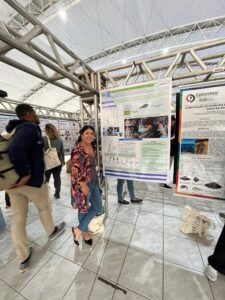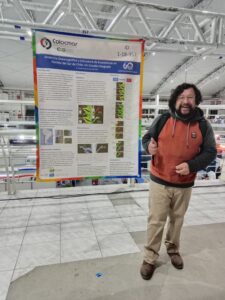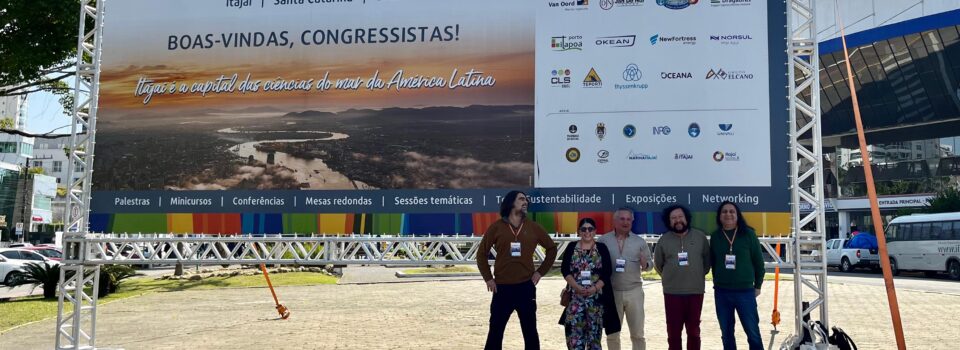Outstanding participation of IFOP in Latin American Congress of Marine Sciences
August 23rd, 2024Between August 13 and 16, in Itajaí, State of Santa Catarina, Brazil, the 20th edition of the Latin American Congress of Marine Sciences (COLACMAR) was held. It is the most important technical-scientific event of Marine Sciences in Latin America. The professionals from the Fisheries Development Institute participated, Karen Belmar, Vladimir Murillo, Francisco Leiva, Fernando Espíndola and Heraldo Contreras.
Summary of their presentations at the congress
Karen Belmar
 The paper “Tagging of Dosidicus gigas in Chile: progress and challenges” presented the methodology and preliminary results of the tagging of cuttlefish in Coquimbo and Lebu. Horizontal and vertical movement of the specimens, characteristics of these movements. In addition, the advances in terms of protocols and operational difficulties were shown. The research is funded by the UNDP Project “Catalyzing the implementation of a Strategic Action Program for the Sustainable Management of Shared Living Marine Resources in the Humboldt Current System, Humboldt II Project”
The paper “Tagging of Dosidicus gigas in Chile: progress and challenges” presented the methodology and preliminary results of the tagging of cuttlefish in Coquimbo and Lebu. Horizontal and vertical movement of the specimens, characteristics of these movements. In addition, the advances in terms of protocols and operational difficulties were shown. The research is funded by the UNDP Project “Catalyzing the implementation of a Strategic Action Program for the Sustainable Management of Shared Living Marine Resources in the Humboldt Current System, Humboldt II Project”
Vladimir Murillo
Within the framework of the study carried out by IFOP in the regions of Los Lagos, Aysén and Magallanes, environmental information was integrated from the Environmental Reports (INFA), which include sampling under the farming centers, and from the IFOP sampling campaigns, which cover sectors adjacent to these centers. The analysis, focused on the period 2012-2022, described the spatial behavior of the data organized by Salmonid Concession Group (ACS) and evaluated changes in the environmental conditions of the sedimentary bottoms based on the variables EhNHE, MOT and pH (i.e. categories “acceptable”, “transition” and “transition”). The results showed that the prevailing environmental conditions in each ACS have maintained their historical behavior, in accordance with previous studies. However, the EhNHE and pH variables presented greater spatial variability and a less favorable performance (i.e. “not acceptable” and “transition,” respectively), which is mainly reflected in the EhNHE of the INFA data.
Francisco Leiva
A presentation was made on the hydroacoustic evaluation of small pelagic fish. A review of the history and the main advances of the last 100 years was made. The technique and its basic principles were described, highlighting the importance of frequency selection, pulse selection, sampling design and the relationship of TS to size. Limitations in the studies were shown and finally a brief review of the work carried out by the Department of Direct Evaluations, at IFOP, Chile, was made.
Fernando Espíndola
The different stock assessment models that are applied for small pelagic fishes along the coast of Chile were described, highlighting the main differences and assumptions that are assumed for each of them, e.g. some stock assessment models incorporate fishery information on sizes and others on ages. In addition, the latest analyses developed for northern Chilean anchovy on the application of the Evaluation of Management Strategies (EEM) through the use of the openMSE software to evaluate the performance of the current and alternative fishery management procedures in achieving a set of objectives that are defined in the fishery management plan for the Spanish anchovy and sardine fishery of the Arica and Parinacota, Tarapacá and Antofagasta Regions (Res. Ex. No. 1197, 2018) were presented.
Heraldo Contreras Cifuentes
 Information from hydrodynamic models developed by IFOP was integrated with the results of benthic sampling in the Compu and Quitralco fjords. The relationship between the dynamics of water age and dissolved oxygen with the physical, chemical and biological characteristics of sediments was analyzed along a gradient from head to mouth in these fjords. The study revealed significant environmental gradients in water age and dissolved oxygen, as well as a close relationship between these variables and the benthic ecosystem. For example, it was observed that low circulation at the head of the fjords tends to accumulate organic matter, which negatively affects the community structure of the macroinfauna. These findings highlight the importance of integrating oceanographic dynamics into territorial management and salmon farming to ensure sustainable aquaculture development and the conservation of marine ecosystems.
Information from hydrodynamic models developed by IFOP was integrated with the results of benthic sampling in the Compu and Quitralco fjords. The relationship between the dynamics of water age and dissolved oxygen with the physical, chemical and biological characteristics of sediments was analyzed along a gradient from head to mouth in these fjords. The study revealed significant environmental gradients in water age and dissolved oxygen, as well as a close relationship between these variables and the benthic ecosystem. For example, it was observed that low circulation at the head of the fjords tends to accumulate organic matter, which negatively affects the community structure of the macroinfauna. These findings highlight the importance of integrating oceanographic dynamics into territorial management and salmon farming to ensure sustainable aquaculture development and the conservation of marine ecosystems.
